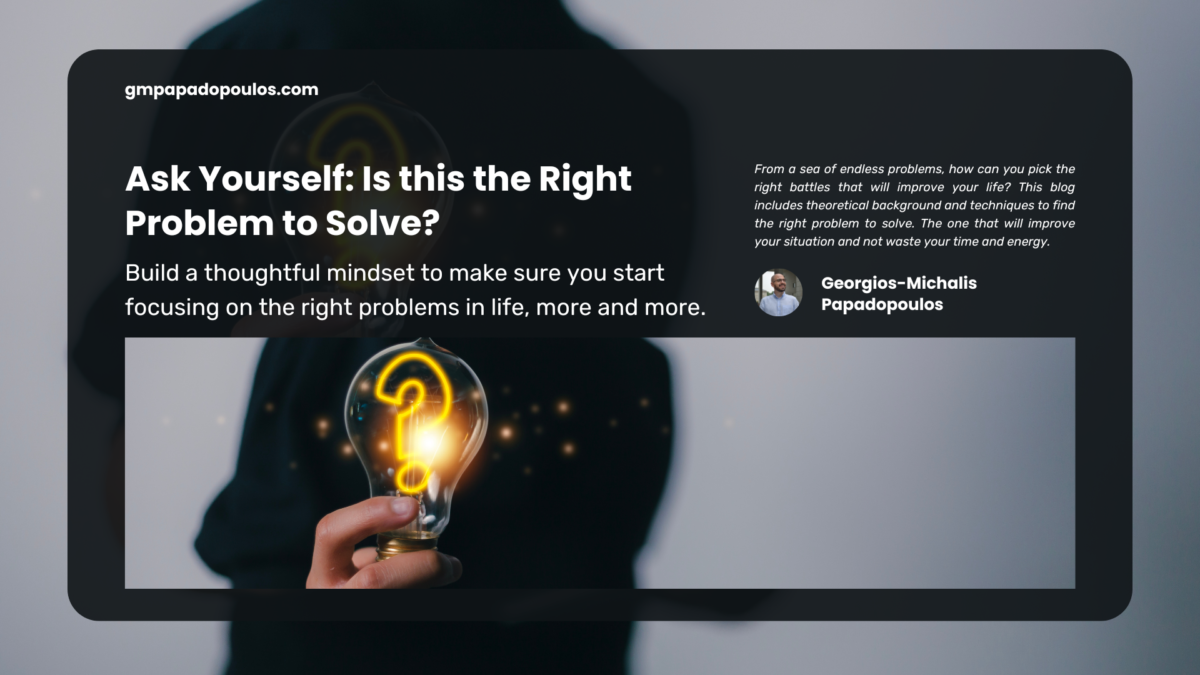Kalimera/Dzien Dobry/Good day and best wishes for your winter! Dive in, if:
- You’re looking to learn more about conflict transformation.
- You want to become better at finding the root causes of a problem.
- You enjoy learning from resources with a storytelling approach and witty humor.
Imagine you’re returning from a harsh day at work – as 2024 has been the RTO year, and this is again becoming a reality for millions of office workers across the globe.
When I say a harsh day, I mean a severe one; I mean it! Think of your boss scolding you in an open office setting, messing up a key project presentation to a C-executive, or going to school with no pants, like your dreams.
A day so horrible you want to storm to your home, hug the blanket, turn on the laptop, and watch Netflix for 5 hours straight.
But you’re an organized, thoughtful individual. A real adult! It ain’t your first rodeo, and for such days, you have planned. There’s a Ben & Jerry’s hiding (any Vegan Netflix & Chilled enjoyers here?) in the back corner of your freezer, waiting for you.
You count the minutes. Commuting back, fighting tears, waiting to unlock the door. You rush to the kitchen, immediately putting the plan into action. But then.
When you do…
You get to see your worst possible outcome.
Your roommate/sibling/significant other/cat is there, with the freezer door open, a spoon in their left hand, and your own Ben & Jerry’s on their right.

Turns out they also had a bad day at work (yes, even the cat).
Turns out, they ain’t sharing. Nope, it’s their Ben & Jerry’s now. They don’t care, they’ll pay you. Triple the original price, even. They need this!
The closest store selling it is too far away. No one has the mood to go out after such a catastrophe.
You’ve entered into your worst nightmare;
You’ve entered into a conflict.
The good thing is, that’s an article about them; how to navigate them, understand their players and their needs, and find solutions – ones that cater to each other’s goals and aspirations.
Ready?
Table of Contents
Definitions of Conflict Transformation
Johan Galtung, a Norwegian Sociologist, has devoted his life to conflict theory, in a long span of 93 years that, sadly, ended in 2024. Rest in peace, Johan!
His work is the cornerstone of this blog, which I learned while in Vienna, Austria, for an Erasmus+ Training Course organized by Ecological Future Education and EMOTiC – Training and Consulting. Kudos to Sakr for being an amazing instructor and, if you don’t know what Erasmus+ Training Courses are, pay a visit to my previous article!
A solid starting point when researching any topic is the definitions. And, based on Johan Galtung, the two we need to focus on are:
- Conflict: Actor(s) in pursuit of incompatible goals. (Galtung, 2009)
Notes: as conflict can be internal, the actor can be one – although, still, two opposing pieces of oneself argue with one another.
- Conflict Transformation: The process of moving from conflict-habituated systems to peace systems. This process is distinguished from the more common term of conflict resolution because of its focus on systems change. (Botes, 2003)
- Transcendence in Conflicts: Creating a new kind of reality (within the conflict) (The Transend Method. 2004)
Hold these down. You’ll need them as we move along.
What can occur from a Conflict: Conflict Outcomes & Negotiations
Guess what – conflicts and negotiations can go hand in hand! And if you want to get better at negotiations, I’ve also got you covered; here are nine great tips to consider!
That was my reaction when I was reintroduced to the Negotiation Strategy Matrix in Vienna, but with a different name and from the perspective of conflict transformations.
What does it say? Within two axes, x (their objectives) & y (our objectives), you can encounter 5 different scenarios.

- Lose Lose: Most commonly, this resembles the lack of a deal.
- Lose Win: We lose, and they win.
- Win Lose: We win, and they lose.
These are three scenarios that can be, actually, all completely plausible in situations.
For example for each:
- A no-deal can be something to seek if it aligns with our goals or strategy.
- It can cater to our needs, as the importance of a relationship is far too important, and the issue is not. Ex. the negotiations are with our key client, so caving to a specific request would ensure we don’t risk any strains.
- We might not care for the relationship itself, so we can just push our position. Works if we also hold the power in the negotiations.
As you can also see, the importance of the parties’ relationship, the issue at hand, and the power dynamics, are key components of any negotiation.
Wait a minute, you may say; didn’t you say there are five outcomes? These are three, you scum!
Wow, impatient (and rude, if you called me scum)! Yes, there are two more. Which are:
- Compromise: Both parties win and lose something.
A compromise might seem like the goal of the negotiation. And it certainly can be, in some instances. Sometimes a deal must be reached quickly, so in the absence of time, you need a consensus now.
But, there’s a fifth outcome.
- Win-Win: Both parties win!
How is this possible? By bringing transcendence into conflicts!
Let’s go back to our ice cream situation.
- Lose-Lose: You fight, and while fighting the ice cream falls to the ground. No one will eat it from the floor, as you haven’t cleaned in days (you dirty bastards).
- Lose-Win or Win-Lose: You fight, and one manages to win the ice cream. And guess what? It’s cold, as your cold, distant heart.
- Compromise: You decide to do something about it; you accept the money, or share the ice cream. It works, but you’re both somewhat disappointed.
Obvious examples. Right?
What transcendence would look like in this case, though?
How about taking a step back, and considering the situation more thoroughly?
- You may remember that ice cream is comforting, but some fried chicken might be even better! So you make the other party
- You are both disappointed; so why not just help each other? You can do an activity you might enjoy together.
- And, if it’s the cat, give it some catnip dude.
Remember? It ain’t about the ice cream – it’s about your horrible day.
So, do remember: Many times, the real problems lie far deeper than the actual causes of conflicts.
Conflict Transformation & Transcendence
Transcendence works when you manage to get to the root of your real problem, something I have discussed in one of my previous blog posts.

By getting to a new reality, and thinking out of the rigid box of your negotiations, you’re now looking at more possibilities, like
- Adding tradeables to your deal
- Investigate mutually beneficial solutions
- Creating something together, etc.
All these solutions were reviewed in the ice cream war example. Ex. in this case KFC is a tradeable, a common activity is to investigate mutually beneficial solutions and create something together.
Taking a transcending approach to a conflict, and altering how we view systems to lead to positive peace, is what conflict transformation is all about; separating itself from conflict resolution.
Disclaimer: there are two kinds of peace; positive & negative, but this article would have run too long if it was to dig deeper into such a concept. Do let me know if you would love a part 2!
And, you may ask; how can I implement all these in real life?
You’re quite impatient once more, aren’t you? It’s literally in the next section!
Improving your Conflict Transformation Skills with One Single Step
Conflicts as a subject fascinate me, as it is heavily related to so many other disciplines I love reading about; politics, history, and business.
However, I wanted to make this article as applicable as I can, to be used in anyone’s daily life, personal or professional.
You see, conflicts are emotional.
This means that, as humans, we face them on the daily.
Emotions can run high. We get blinded by our feelings, and we act in ways we wouldn’t have.
Leading us to regret our actions. Something that, probably, everyone can empathize with. At least, I know I do.
Yet, while you cannot change the problems of the past, you may work your way through better in the next conflicts.
And if you feel bad about it, don’t! Conflicts are not most people’s forte. In fact:
- 49% of emerging leaders struggle with managing conflict in the workplace (DDI, 2024).
- 49% of workplace conflicts arise from personality clashes and warring egos (Myers-Briggs Company, 2008).
- 27% of employees have seen conflicts escalate to personal attacks (Myers-Briggs Company, 2008).
So, what to do when you are faced with one the next time? How can you become better at conflict transformation?
Take a step back. Give yourself some time, if possible. Don’t act impulsively.
And, when you’re ready, come back, and ask the right questions – to the other party and yourself.
I could stay here and talk about problem & solution trees (which you can read about if you’re interested in sustainability from this resource), fishbone diagrams, and so on.
But the most important thing is to push and ask the right questions.
Try it yourself – it’s the most powerful thing you can do.

List of Conflict-Related Questions
Here are some questions that can improve your conflict transformation skills, given to us within the programme. But, of course, you can think of more, depending on your situation!
History and Dynamics?
- When and why did the conflict start?
- What had happened so far?
- How do the actors see the main events?
- How did the intensity of conflict change?
Actors?
- Who are the involved actors?
- How do they relate to each other?
- What are the powers/positions/needs?
Causes?
- What are the root causes of the problem?
- Which causes are most critical?
- What are the effects?
Don’t be Afraid of Conflicts.
Conflicts suck, right?
… Do they?
Sure, they carry with them a lot of discomfort, having to confront the other, as well as ourselves.
But, from that distress, we can find ways to grow.
In the training course, we thought of numerous reasons why conflicts can be a benefit. Like:
- Opportunity to reflect and change
- Clarifies the importance of matters (for us and other parties)
- Clarifies relationships and connections, feelings, etc.
- Increases understanding of self-awareness
- Unveil misunderstandings
- Creates space for improvement
And I am sure that, if prompted, you can think of more yourself.
I want to close with this: We, humans, are wired to take the path of least resistance. But that road leads to stagnation. That course leads to nowhere.
So, you owe it to yourself to push on.
Give conflicts a chance; but have them the right way, next time.
—
Enjoyed such philosophical closure?
It’s no wonder I wrote it this way; as recently, I’ve decided to delve into philosophy a lot.
The result? Many, many questions.
But also, my very own podcast, After The Dragon.

After the Dragon is a reflective, existential podcast, about navigating life’s changes, self-discovery, and the journey of personal growth.
Blending insights from philosophy, life and death, politics, sciences, and everything in between, with personal storytelling.
Intrigued? You can listen to the first six episodes on Spotify or YouTube. And if you do, let me know your thoughts!

Comments are closed.